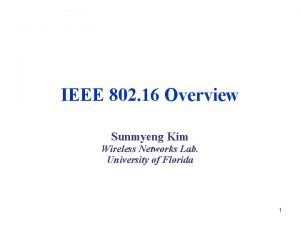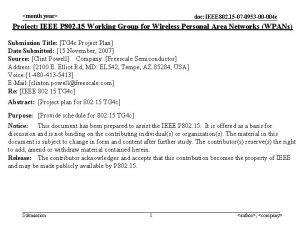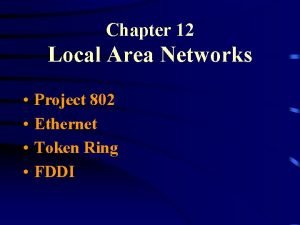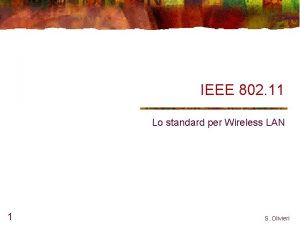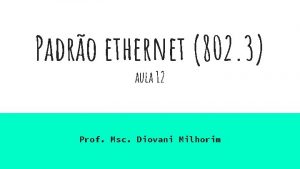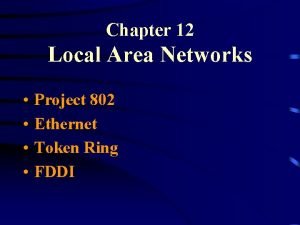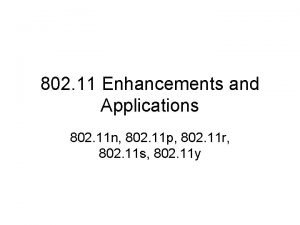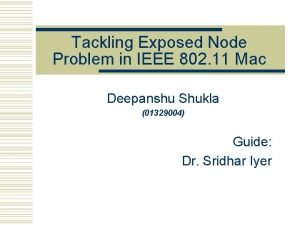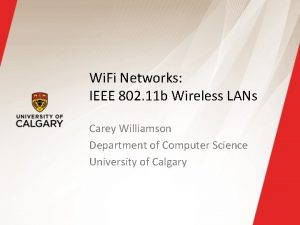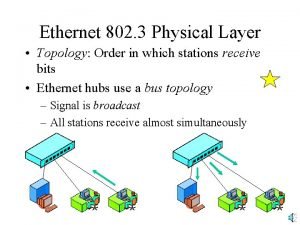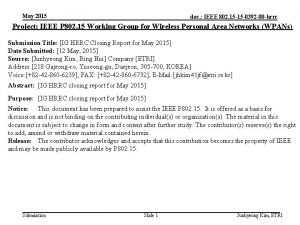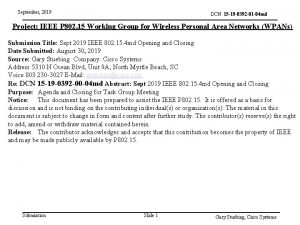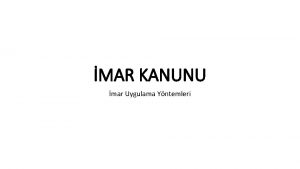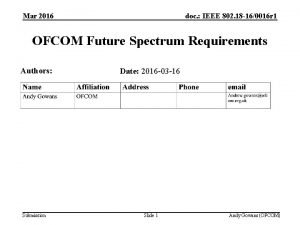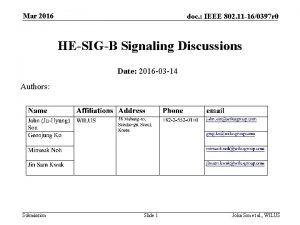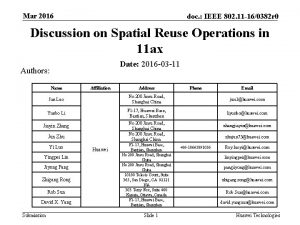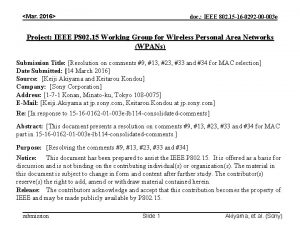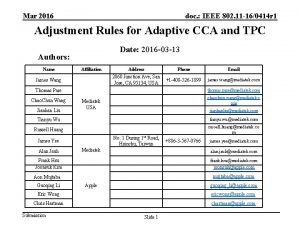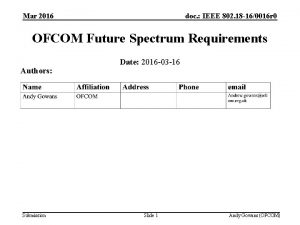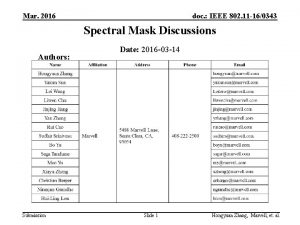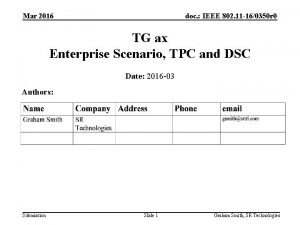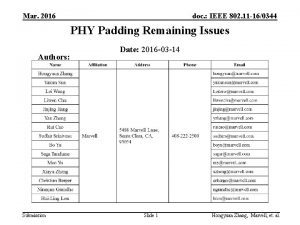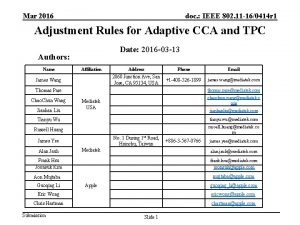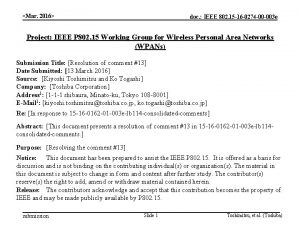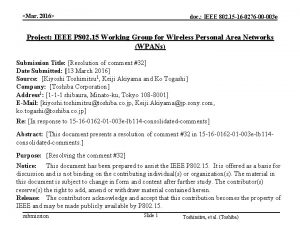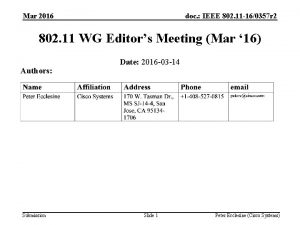Mar 2016 doc IEEE 802 11 16 0392
















![Mar 2016 doc. : IEEE 802. 11 -16 -0392 r 0 References [1] IEEE Mar 2016 doc. : IEEE 802. 11 -16 -0392 r 0 References [1] IEEE](https://slidetodoc.com/presentation_image/19e11dfce05faa314f036cb89f634e74/image-17.jpg)





- Slides: 22

Mar 2016 doc. : IEEE 802. 11 -16 -0392 r 0 Antenna Pattern Decoupling Operation in 802. 11 ay Channel Modeling Date: 2016 -03 -17 Authors: Submission Slide 1 Kun Zeng, Huawei Technologies

Mar 2016 doc. : IEEE 802. 11 -16 -0392 r 0 Motivation • The effects of antenna pattern should be carefully considered in high frequency channel modeling, ‒ Measurements in low frequency bands (<6 GHz) have used omni-directional/sector antennas, while the same antenna configuration is also applied for operating environment. ‒ However, in the higher frequency bands, antenna pattern should be taken into account in system design. If different antenna patterns are applied to channel measurements and system operations, the channel model obtained may not be fully helpful for system design. • Quasi-Deterministic (Q-D) approach [1] has been proposed in 802. 11 ay channel modeling. In this approach, channel models consist of two folds: deterministic components (i. e. , D-rays) and random components (i. e. , R-/F- rays). D-rays are simulated by ray-tracing method and R-/F- rays are extracted from channel measurements. • This presentation addresses the impact of antenna patterns on channel measurement and proposes decoupling the channel modeling from antenna patterns, which we think to be essential in Q-D channel modeling. Submission Slide 2 Kun Zeng, Huawei Technologies

Mar 2016 doc. : IEEE 802. 11 -16 -0392 r 0 Outline • An example of the effects of antenna patterns • Antenna pattern decoupling operation in Q-D model • Summary Submission Slide 3 Kun Zeng, Huawei Technologies

Mar 2016 doc. : IEEE 802. 11 -16 -0392 r 0 An Example of the Effects of Antenna Patterns Submission Slide 4 Kun Zeng, Huawei Technologies

Mar 2016 doc. : IEEE 802. 11 -16 -0392 r 0 Measurement Campaign for Indoor Scenario @73 GHz* Picture (Open office at U 2 building of Chengdu Huawei Research Center) Floor plan * Here the results@73 GHz is presented as a reference to illustrate the effects of antenna pattern in channel measurement. Kun Zeng, Huawei Technologies Submission Slide 5

Mar 2016 doc. : IEEE 802. 11 -16 -0392 r 0 Measurement Campaign for Indoor Scenario @73 GHz (2) • LOS and NLOS are both considered. Main measurement parameters Tx height (m) 2. 16 Rx elevation sweep N/A Rx height (m) 1. 8 Central frequency (GHz) 73 Tx azimuth (deg) 0 Bandwidth (GHz) 1 Tx elevation (deg) 0 Freq. sweep points 1001 Tx location Static Tx antenna Waveguide/ 10 d. Bi Rx location Static Rx antenna Horn/ 20 d. Bi, 25 d. Bi, 30 d. Bi Polarization Vertical Rx azimuth sweep (deg) 0~359 Rx azimuth sweep step (deg) 1 Submission LOS 15. 4 NLOS 12. 4 Tx-Rx distance (m) Slide 6 Measurement antenna patterns Kun Zeng, Huawei Technologies

Mar 2016 doc. : IEEE 802. 11 -16 -0392 r 0 Power Angular Spectrum (PAS) LOS NLOS Lobe 1 Lobe 3 Power (d. B) Lobe 2 Azimuth angle (deg) • Lobe 2 Azimuth angle (deg) Observations: ‒ Three lobes are presented; ‒ For different antenna patterns, the measured PAS are different; Submission Slide 7 Kun Zeng, Huawei Technologies

Mar 2016 doc. : IEEE 802. 11 -16 -0392 r 0 Angular Spread (AS) • AS are estimated from the measured PAS and based on the extraction procedure presented in WINNER II channel models [2]. Cases LOS NLOS Rx antennas AS (deg) Lobe 1 Lobe 2 Lobe 3 Global 30 d. Bi 2. 9 2. 7 4. 5 26. 2 25 d. Bi 5. 6 5. 5 7. 0 34. 9 20 d. Bi 5. 6 6. 0 14. 3 40. 9 30 d. Bi 3. 2 5. 7 46. 3 25 d. Bi 9. 7 6. 6 5. 7 50. 4 20 d. Bi 11. 6 6. 7 5. 7 41. 8 • From the table, it is observed that the values of AS with different Rx antenna patterns are different. • It implies a necessity that the effect of antenna patterns on the extracted parameters for channel modeling be removed. Submission Slide 8 Kun Zeng, Huawei Technologies

Mar 2016 doc. : IEEE 802. 11 -16 -0392 r 0 Antenna Pattern Decoupling Operation in Q-D Channel Modeling Submission Slide 9 Kun Zeng, Huawei Technologies

Mar 2016 doc. : IEEE 802. 11 -16 -0392 r 0 Relationship between Ideal and Measured Channel • In general, the relationship between ideal (pure propagation) channel and measured channel can be expressed as Ideal channel, eq. (3. 1) in [1] Measured channel Tx antenna pattern Rx antenna pattern Measured_Channel = Ideal_Channel ‒ ‒ ‒ Submission Antenna_Pattern -- convolution operation; L, M -- the antenna pattern resolution in the azimuth and elevation plane, respectively; p , Ω -- the amplitude and phase of the (l, m)antenna pattern resolution unit, respectively. Slide 10 Kun Zeng, Huawei Technologies

Mar 2016 doc. : IEEE 802. 11 -16 -0392 r 0 Relationship between Ideal and Measured Channel (2) • In Q-D approach, the channel model consists of two parts, Channel = Deterministic_channel_components + Random_channel_components where • • ‒ Deterministic_channel_components are simulated by ray-tracing; ‒ Random_channel_components are obtained from channel measurements; Antenna pattern can be set to the isotropic configuration in ray-tracing. Therefore, the effects of antenna pattern mainly occur in random components modeling in Q-D. Submission Slide 11 Kun Zeng, Huawei Technologies

Mar 2016 doc. : IEEE 802. 11 -16 -0392 r 0 Antenna Pattern Decoupling • Basically, “antenna pattern decoupling” can be defined as the operation of decoupling the channel model from the measurement antenna patterns, which can be expressed as Ideal_Channel = Measured_Channel Antenna_Pattern Measured PAS θ Antenna Pattern Decoupling Antenna pattern info. Power Measured PAS θ 1 θ 2 θ 3 θ 4 θ 5 θ 6 θ 7 Antenna pattern-independent channel/Angular distribution in the actual channel Submission Slide 12 Kun Zeng, Huawei Technologies θ

Mar 2016 doc. : IEEE 802. 11 -16 -0392 r 0 How to Generate the Simulation Channel • Since the channel model is ideal and should be independent of antenna patterns, in simulations, the effect of antenna patterns should be compensated/reconstructed. Simulation_Channel = (Deterministic_channel_components + Random_channel_components ) Antenna_Pattern Submission Slide 13 Kun Zeng, Huawei Technologies

Mar 2016 doc. : IEEE 802. 11 -16 -0392 r 0 Procedure of Antenna Pattern Decoupling Operation • Antenna Decoupling Application/ Verification The general procedure of antenna pattern decoupling should include the following steps: ‒ Step 1: estimate the path of propagation (angular domain/delay domain/both); ‒ Step 2: remove the measurement antenna pattern**; ‒ Step 3: reconstruct/compensate the extracted data with measured/new antenna pattern; ‒ Step 4 (optional): evaluate the effect of reconstruction and antenna decoupling ** There are couples of methods to achieve Step 2, such as MUSIC[Schmidt], CLEAN[Clarke] or SAGE[Fessler] algorithm in the field of signal processing, and so on. This step can be treated as an inverse problem. Submission Slide 14 Kun Zeng, Huawei Technologies

Mar 2016 doc. : IEEE 802. 11 -16 -0392 r 0 General Criterion for Antenna Pattern Decoupling • To guarantee the performance of antenna pattern decoupling operation, we suggest the following criterion to evaluate the effectiveness of specific decoupling algorithm. Min │Reconstructed_Channel – Orignal_Measured_Channel│2 MSE – Minimum Squared Error Submission Slide 15 Kun Zeng, Huawei Technologies

Mar 2016 doc. : IEEE 802. 11 -16 -0392 r 0 Summary • The effect of antenna patterns should be considered in 802. 11 ay channel modeling. • This effect mainly affects the random components modeling in the QD channel modeling method. • In this presentation, we propose considering antenna pattern decoupling operations as an essential processing step in Q-D channel modeling. • In addition, we propose a general criterion to evaluate the effectiveness of antenna pattern decoupling. Submission Slide 16 Kun Zeng, Huawei Technologies
![Mar 2016 doc IEEE 802 11 16 0392 r 0 References 1 IEEE Mar 2016 doc. : IEEE 802. 11 -16 -0392 r 0 References [1] IEEE](https://slidetodoc.com/presentation_image/19e11dfce05faa314f036cb89f634e74/image-17.jpg)
Mar 2016 doc. : IEEE 802. 11 -16 -0392 r 0 References [1] IEEE 802. 11 -15/1150 r 2, “Channel Models for IEEE 802. 11 ay” [2] IST-4 -027756 WINNER II D 1. 1. 2 v 1. 0, “WINNER II Channel Models, Part II- Radio Channel Measurement and Analysis Results” Submission Slide 17 Kun Zeng, Huawei Technologies

Mar 2016 doc. : IEEE 802. 11 -16 -0392 r 0 Backup: Preliminary Results for Antenna Pattern Decoupling Operation (LOS case) Original PAS before antenna pattern decoupling Submission Extracted Angular distribution after antenna pattern decoupling Slide 18 Kun Zeng, Huawei Technologies

Mar 2016 doc. : IEEE 802. 11 -16 -0392 r 0 Backup: Preliminary Results for Antenna Pattern Decoupling Operation (LOS case) Reconstructed PAS (black: original ; red: reconstructed) Cases LOS Submission Slide 19 Rx antennas Deviation btw O&R (d. B) 30 d. Bi 0. 1 25 d. Bi 0. 1 20 d. Bi 0. 1 Kun Zeng, Huawei Technologies

Mar 2016 doc. : IEEE 802. 11 -16 -0392 r 0 Backup: Preliminary Results for Antenna Pattern Decoupling Operation (NLOS case) Original PAS before antenna pattern decoupling Submission Extracted Angular distribution after antenna pattern decoupling Slide 20 Kun Zeng, Huawei Technologies

Mar 2016 doc. : IEEE 802. 11 -16 -0392 r 0 Backup: Preliminary Results for Antenna Pattern Decoupling Operation (NLOS case) Reconstructed PAS (black: original ; red: reconstructed) Cases LOS Submission Slide 21 Rx antennas Deviation btw O&R (d. B) 30 d. Bi 0. 5 25 d. Bi 0. 5 20 d. Bi 0. 3 Kun Zeng, Huawei Technologies

Mar 2016 doc. : IEEE 802. 11 -16 -0392 r 0 Straw Poll 1 • Would you agree that 11 ay channel modeling shall incorporate antenna pattern independent methodology? • Y-N-A: Submission Slide 22 Kun Zeng, Huawei Technologies
 Bridges from 802.x to 802.y
Bridges from 802.x to 802.y Bridges from 802.x to 802.y
Bridges from 802.x to 802.y Ieee 802 standard
Ieee 802 standard Ieee 802 bluetooth
Ieee 802 bluetooth 802 ieee
802 ieee Ieee 802
Ieee 802 Ieee 802 family
Ieee 802 family Ieee 802 3 compliance
Ieee 802 3 compliance Ieee 802
Ieee 802 Arquitetura ieee 802
Arquitetura ieee 802 Ieee 802 que es
Ieee 802 que es Modulation coding scheme
Modulation coding scheme 802 15
802 15 Project 802 in data communication network
Project 802 in data communication network 802/11
802/11 802 3
802 3 Project 802
Project 802 802 11 n
802 11 n Exposed node problem
Exposed node problem 802 11 b
802 11 b 507-802-380
507-802-380 Physical layer topology
Physical layer topology Geo 802
Geo 802











